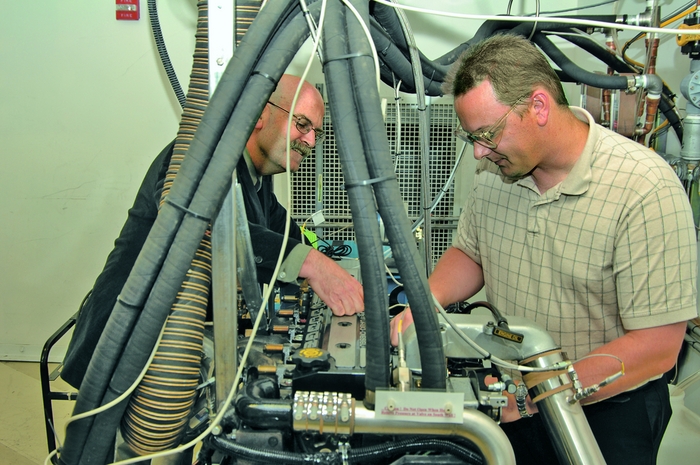Advertisement
Grab your lab coat. Let's get started
Welcome!
Welcome!
Create an account below to get 6 C&EN articles per month, receive newsletters and more - all free.
It seems this is your first time logging in online. Please enter the following information to continue.
As an ACS member you automatically get access to this site. All we need is few more details to create your reading experience.
Not you? Sign in with a different account.
Not you? Sign in with a different account.
ERROR 1
ERROR 1
ERROR 2
ERROR 2
ERROR 2
ERROR 2
ERROR 2
Password and Confirm password must match.
If you have an ACS member number, please enter it here so we can link this account to your membership. (optional)
ERROR 2
ACS values your privacy. By submitting your information, you are gaining access to C&EN and subscribing to our weekly newsletter. We use the information you provide to make your reading experience better, and we will never sell your data to third party members.
Business
Using Pore Power
New zeolite technologies help refiners crack crude and trucks clean up emissions
by Melody M.Bomgardner
January 24, 2011
| A version of this story appeared in
Volume 89, Issue 4

Declining crude oil quality and rising air pollution standards are hurdles for the refining industry, but they are growth opportunities for manufacturers of zeolites. When used in catalysts for petroleum refining and diesel emissions reduction, zeolites are enjoying a demand boom that is prompting investment and attracting at least one new player.
Specialized synthetic zeolites are a key ingredient in catalysts used for fluid catalytic cracking (FCC). This refining process converts high-molecular-weight, high-boiling-point hydrocarbons into valuable transportation fuels.
Zeolites are microporous materials created by combining silica and alumina under controlled temperature and pressure, sometimes with an organic template that precisely directs the arrangement of the pore spaces. In an FCC unit, the lattice structure of the zeolite allows only petroleum molecules of a specific size to enter the highly acidic pore sites. The microspheres of zeolite-containing catalysts then break down the oil.
FCC catalyst technology is largely in the hands of chemical heavyweights such as W.R. Grace, Albemarle, and BASF. These firms also dominate a global synthetic zeolite industry worth about $1.9 billion a year, according to Raghu Tantry, senior industry analyst at consulting firm Frost & Sullivan. Most products serve petroleum refiners.
Many of the difficulties refiners face are a boon to sellers of specialized zeolites. For example, the largest market for synthetic zeolites is in helping refiners bridge the gap between the lower quality crude oil now commonly used as feedstock and cleaner burning fuels demanded by regulators and the marketplace.
This dynamic is helping to drive sales of synthetic zeolites. “FCC is a growing market for zeolites, with rates around 5% or so per year,” Tantry says. “That’s higher than any commodity product, which would be growing at the rate of the economy, around 2%.”
Although the big players in catalysis have been fairly quiet on the investment front, two smaller pure-play firms with enhanced zeolite technologies say their products will expand the ways in which zeolites are used in the fossil-fuel industry.
Venture-backed start-up firm Rive Technology will attempt to enter the market for FCC zeolites with its method for introducing larger pore spaces into synthetic zeolites. Meanwhile, longtime zeolite manufacturer Zeolyst is going after a new market on the back end of the fossil-fuel chain. Its specialty zeolite catalysts are used in new diesel emissions control systems that meet more stringent U.S. air pollution regulations.
Rive was cofounded in 2006 by chemist Javier Garcia Martinez and is based on discoveries he made as a postdoctoral student at Massachusetts Institute of Technology. As a nanotechnologist, he became interested in improving the performance of the Y-type, or faujasite, zeolites used in FCC units. Garcia Martinez found a way to use surfactants to form larger pore spaces in zeolites and to control the size and concentration of these mesopores.
Rive’s process begins with the common Y-type zeolite, which has pore sizes of 7–8 Å, or a little less than 1 nm, and introduces pores in the 35–40-Å range. The large pore sizes mean “we allow bigger molecules to get in and participate in the party,” says Larry Dight, senior vice president of R&D at Rive.

“Currently, the larger molecules either can’t get in at all or have to be cracked in a different matrix component that is not as selective,” Dight says. By creating the larger pores, “we’re introducing these highways into smaller arteries and opening things up.”
If the desired products of the cracking process—gasoline or diesel—spend too much time in the catalyst, they can be “overcracked” into light gases or other less desirable products. “You want to have them exit the zeolite as fast as you can,” Dight explains.
Another benefit of the altered zeolites, Dight says, is that they reduce the production of coke, a carbonaceous material that creates deposits on the catalyst. “If you make less coke, you can circulate the catalyst faster,” he claims. “It makes the FCC unit happier and more active, and the operator can put more barrels through the system.”
Although Rive has no customers for its zeolite-improvement technology yet, it raised $25 million in December 2010 in a third round of venture funding. And, in August 2010, it inked a development and commercialization agreement with Grace. The partnership is a major step for Rive because Grace will formulate catalysts with Rive’s zeolites and take on critical manufacturing responsibilities.
Grace also brings its specialty in formulations to the partnership. “The zeolite is only one component, maybe a third of the catalyst,” Dight points out. “Other components such as metals-trapping technology are the expertise of the catalyst manufacturer.”
The goal is to have a drop-in zeolite-based catalyst for FCC applications. Dight says Rive hopes to conduct as many as three refinery trials during the first half of this year.
Access to Rive’s technology comes at a good time for Grace. “Over time, refineries moved from using cleaner feedstocks to dirtier residual-type feedstocks, which contain high levels of metals and hard-to-crack molecules,” explains Suhakar Jale, senior marketing manager at Grace Davison Refining Technologies. “Grace invests heavily to provide custom solutions that address changes in feedstocks, environmental regulations, and market demand for different types of products.”
In addition to working with Y-type zeolites, Grace introduced a zeolite called ZSM-5 to enhance the production of propylene and other high-value olefins in FCC units.
Zeolyst also makes both Y-type and ZSM-5, along with a number of specialty zeolites, and rising demand has triggered several expansions at the company’s Kansas City, Kan., and Delfzijl, the Netherlands, plants. Zeolyst is a 50-50 joint venture between inorganic specialty chemical maker PQ Corp. and CRI/Criterion, a subsidiary of Royal Dutch Shell.
According to Zeolyst’s general manager, John Lau, a new market has opened up for his firm’s zeolites and is now prompting its fifth plant expansion. In 2010, the Environmental Protection Agency lowered limits on diesel engine emissions of nitrogen oxides. The regulations drove the development of a new control technology for heavy-duty trucks called selective catalytic reduction, or SCR. Zeolyst’s zeolites are used in SCR systems.
Zeolyst has been working on products for this application for a decade. “We have a number of zeolite materials that go into this application,” Lau says. “Our customers combine our zeolites with metals such as copper or iron and deposit them onto a monolith—like a honeycomb—in the form of a wash coat.” Gases from the engine pass through the honeycomb, which, with the help of urea stored in a side tank, reduces the nitrogen oxides into nitrogen, water, and carbon dioxide.
The new SCR systems reduce both soot and nitrogen oxide at the tailpipe, whereas earlier strategies to meet less stringent regulations led engine makers to “de-tune” their engines. Emissions were reduced, but mileage also went down. “What’s incredible about SCR is it not only addresses environmental concerns but allows improvement of between 5 and 9% in the fuel economy of engines,” Lau enthuses.
Although they won’t be sold in the same volumes as products for FCC catalysts, zeolites for environmental applications present a big potential opportunity for manufacturers, Frost & Sullivan’s Tantry says.
And concerns about the eventual “end of oil” do not ruffle the feathers of zeolite makers. Tantry points out that a large new market awaits in creating catalysts for a biogas-to-fuels industry. Rive and Grace say they are already adapting zeolite catalysis to the biofuels world. “There has been a lot of work recently using zeolites in the renewables area and for alternative feedstocks,” Grace’s Jale affirms.




Join the conversation
Contact the reporter
Submit a Letter to the Editor for publication
Engage with us on Twitter